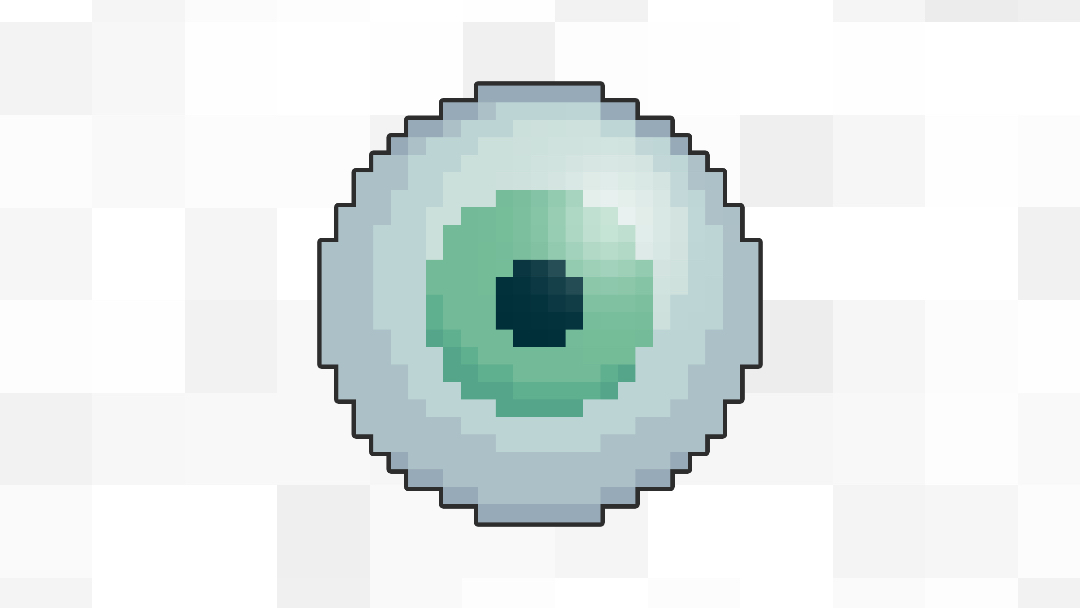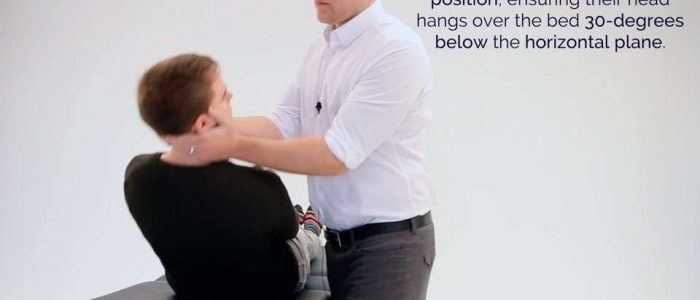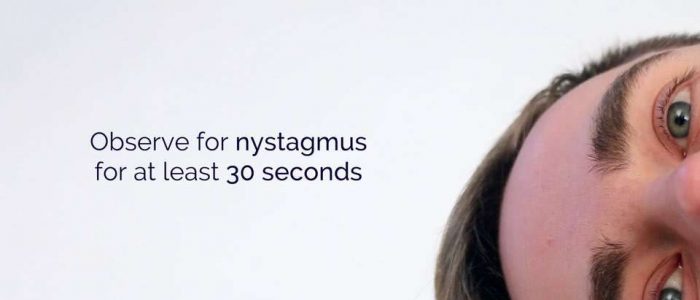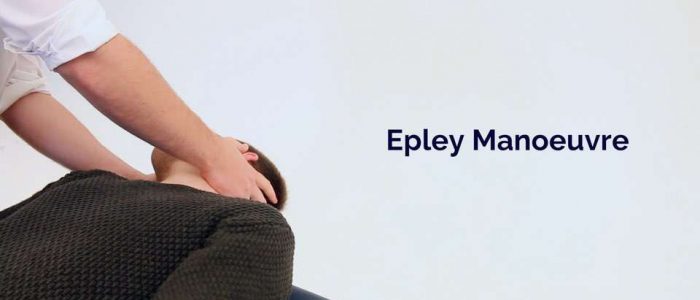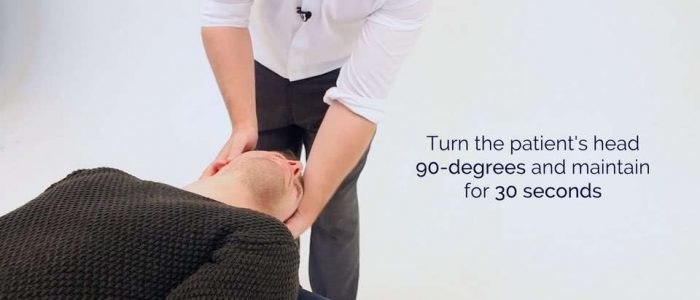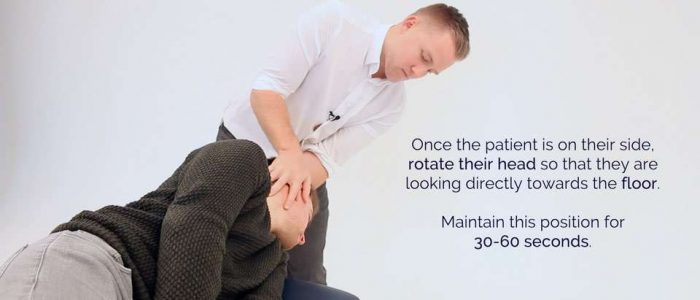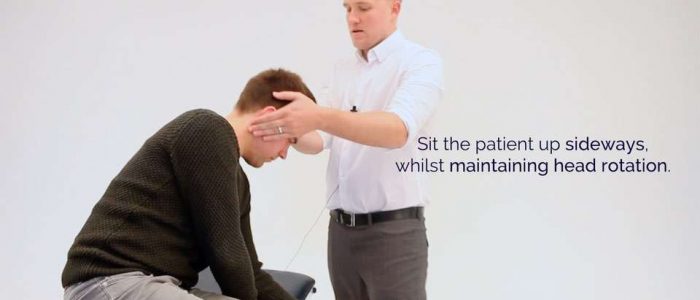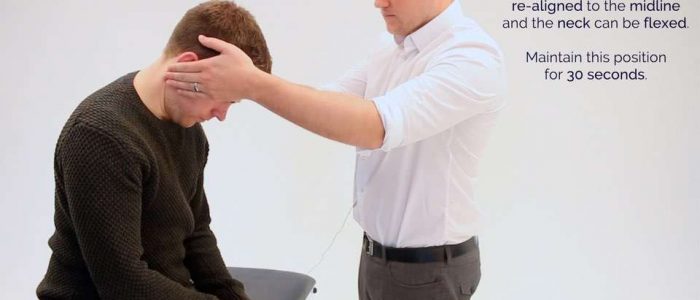- 📖 Geeky Medics OSCE Book
- ⚡ Geeky Medics Bundles
- ✨ 1300+ OSCE Stations
- ✅ OSCE Checklist PDF Booklet
- 🧠 UKMLA AKT Question Bank
- 💊 PSA Question Bank
- 💉 Clinical Skills App
- 🗂️ Flashcard Collections | OSCE, Medicine, Surgery, Anatomy
- 💬 SCA Cases for MRCGP
To be the first to know about our latest videos subscribe to our YouTube channel 🙌
The Dix-Hallpike test is a diagnostic manoeuvre used to identify benign paroxysmal positional vertigo (BPPV) and confirm the affected side (i.e. left or right).
The Epley manoeuvre is used to treat BPPV (usually of the posterior canal) once it has been diagnosed by the previously mentioned Dix-Hallpike test.
This article provides a step-by-step guide to performing both the Dix-Hallpike test and the Epley manoeuvre in an OSCE setting.
Indications for the Dix-Hallpike test
The Dix-Hallpike manoeuvre is indicated for patients with paroxysmal vertigo in whom BPPV is considered in the differential diagnosis. These patients experience vertigo in brief episodes lasting less than one minute with changes of head position and return to normal between episodes. Light-headedness or a sensation of nausea might last longer than one minute, however, if the sensation of movement persists for more than one minute alternative diagnoses should be considered. ¹
Introduction
Wash your hands and don PPE if appropriate.
Introduce yourself to the patient including your name and role.
Confirm the patient’s name and date of birth.
Ask if the patient has noticed whether turning to one particular side seems to trigger the symptoms, which may provide an indication of the affected side.
Briefly explain what the examination will involve using patient-friendly language: “Today I need to perform some assessments to help diagnose and possibly treat the dizzy episodes you’ve been experiencing. The first stage will involve moving you from a sitting to a lying position briskly on the examination couch. The second stage will involve me holding your head whilst asking you to roll onto your side and then to sit upright.”
Check if the patient has any back or neck problems that would contraindicate performing the assessments:
- “Do you have any neck or back problems?”
- “Do you have any pain anywhere currently?”
Check the patient has someone who can help them get home safely, as they may be dizzy after the procedure.
Gain consent to proceed with the examination.
Ask the patient to sit on the examination couch.
Contraindications
It’s important to have an awareness of absolute and relative contraindications to performing the Dix-Hallpike and Epley maneuvres. ²
Absolute contraindications:
- Fractured odontoid peg
- Recent cervical spine fracture
- Atlanto-axial subluxation
- Cervical disc prolapse
- Vertebrobasilar insufficiency
- Recent neck trauma
Relative contraindications:
- Carotid sinus syncope
- Severe neck or back pain
- Recent stroke
- Cardiac bypass surgery within the last 3 months
- Rheumatoid arthritis affecting the neck
- Recent neck surgery
- Cervical myelopathy
- Severe orthopnea
Dix-Hallpike test
When performing the Dix-Hallpike test, make sure to warn the patient in advance of each step, so that they know what to expect:
1. Ask the patient to sit upright on the examination couch.
2. Adjust the patient’s position so that when supine, their head will hang over the edge of the bed, allowing for head extension below the horizontal plane.
3. Position yourself standing behind the patient.
4. Turn the patient’s head 45º to one side (i.e. left or right) – if the patient has suggested turning their head to a particular side appears to trigger the symptoms, you should try this side first.
5. Whilst supporting the neck, move the patient from their sitting position to a supine position in one brisk smooth motion, ensuring their head hangs over the bed 30º below the horizontal plane. Ask the patient to keep their eyes open throughout this process.
6. Inspect the patient’s eyes carefully for evidence of nystagmus for at least 30 seconds.
7. If no nystagmus is observed on the assessment of the first side (i.e. left or right), the test is then complete for that side and you should carefully help the patient sit back up.
8. In the case of a negative Dix-Hallpike test on the first side, after a short break, the test should be repeated on the other side, turning the patient’s head in the opposite direction during step 4. If no nystagmus is observed on assessment of the other side, the patient should be sat up and an alternative diagnosis to BPPV should be considered.
9. If the test is positive, the characteristics of the patient’s nystagmus should be observed (see details below) and you should then consider performing the Epley manoeuvre.
Positive test
If the test is positive, the patient will complain of vertigo and you should be able to observe nystagmus directly.
Be aware that patients often feel very dizzy and nauseated when vertigo is triggered.
Asking the patient to fix their gaze once you’ve established nystagmus will often reduce their symptoms.
Nystagmus
You should note the following characteristics of the nystagmus:
- Duration
- Direction
- Latency
The typical findings in BPPV include:
- A 2-20 second latent period followed by the onset of torsional (rotary) or horizontal nystagmus. Rotary nystagmus is the most common type and suggests the involvement of the posterior semicircular canal. Horizontal nystagmus suggests the involvement of the lateral semicircular canal.
- Nystagmus typically lasts between 20-40 seconds.
- The nystagmus typically wanes with repeated Dix-Hallpike tests.
- Differentiating different types of nystagmus can be clinically challenging. Often patients are referred to an audiologist for further assessment, where special cameras are used to differentiate nystagmus subtypes.
Epley manoeuvre
When performing the Epley manoeuvre, each position should be maintained until full resolution of symptoms and nystagmus has been achieved for at least 30 seconds:
1. The Epley manoeuvre typically follows on from a positive Dix-Hallpike test, so we will assume the patient is still positioned lying flat, with the head hanging over the end of the bed, turned 45º away from the midline towards the affected side.
2. Turn the patient’s head 90º to the contralateral side, approximately 45º past the midline, still maintaining neck extension over the bed. Keep the patient in this position for 30 seconds.
3. Whilst maintaining the position of the patient’s head, ask the patient to roll onto their shoulder (on the side their head is currently turned towards).
4. Once the patient is on their side, rotate the patient’s head so that they are looking directly towards the floor. Maintain this position for 30 seconds to a minute.
5. Sit the patient up sideways, whilst maintaining head rotation.
6. Once the patient is sitting upright, the head can be re-aligned to the midline and the neck can be flexed so that the patient is facing downwards (chin to chest). Maintain this position for 30 seconds.
The entire procedure can be repeated 2-3 times if needed, however, this will depend on whether the patient is able to tolerate further manoeuvres (as they often precipitate vertigo).
To complete the examination…
Explain to the patient that the examination is now finished.
Thank the patient for their time.
Dispose of PPE appropriately and wash your hands.
Summarise your findings.
Example summary
“Today I examined Mr Smith, a 25-year-old male. On general inspection, the patient appeared comfortable at rest and there were no abnormalities noted on inspection.”
“The Dix-Hallpike test on the left elicited vertigo and torsional nystagmus was observed. As a result, I performed the Epley manoeuvre, which resulted in the resolution of symptoms on the first attempt.”
“In summary, these findings are consistent with a diagnosis of BPPV.”
“For completeness, I would like to perform the following further assessments and investigations.”
Further assessments and investigations
- Hearing assessment and otoscopy: if considering inner ear pathology.
- Cerebellar examination: if considering central causes of vertigo.
References
- Jonathan D. Talmud; Peter F. Edemekong. Dix-Hallpike Maneuver. Published on April 10th 2019. Available from: [LINK].
- British Society of Audiology. Recommended Procedure for Hallpike Manoeuvre. Published in 2014. Available from: [LINK].


